In three weeks, the old Louisville Water Company Building on Third Street would have celebrated its 110th anniversary. The Georgian-style building opened on December 19, 1910 in a style that would have stood out among Downtown Louisville’s heavy Victorian architecture.
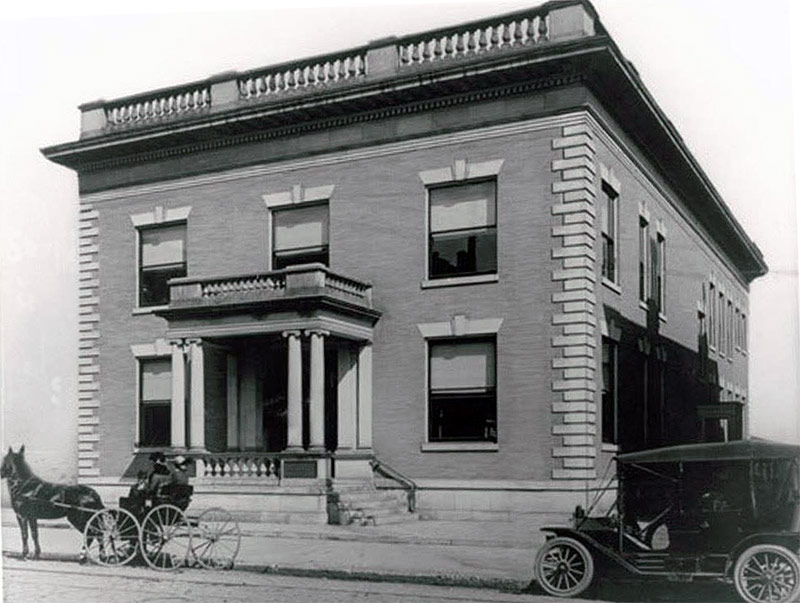
Architect Theodore Liesen crafted the building from buff Roman brick and local limestone, adding just enough detail to maintain respectability while eschewing 19th century excess. The clean and modern structure was his first architectural mark on Louisville, having been appointed chief engineer of the Water Company in 1908. Liesen moved to Louisville from Wilmington, Delaware.
A few years later, he was the president of the local chapter of the American Institute of Architects and was adding a twin structure directly south of the main building. That meter house opened in 1914, the same year Liesen headed to Detroit to head up engineering at its water works. That year, thriving Louisville had a population of 230,000. Ninety years later in 2003, the city had just under 250,000 people.
But that anniversary will never arrive. Wrecking crews were again at the old Water Company site this past week for the third time since August, gnawing away at the last piece of the historic complex.
The long-fraught process is part of the $300 million, 30-story Omni Hotel & Residences slated to cover most of the block and brokered by the city’s economic development wing, Louisville Forward, with $140 million in public funds. The project brings with it 600 hotel rooms, 200 residences, a half dozen retail outlets including a faux grocery store, 800 parking spaces, and two enormous convention center ballrooms.
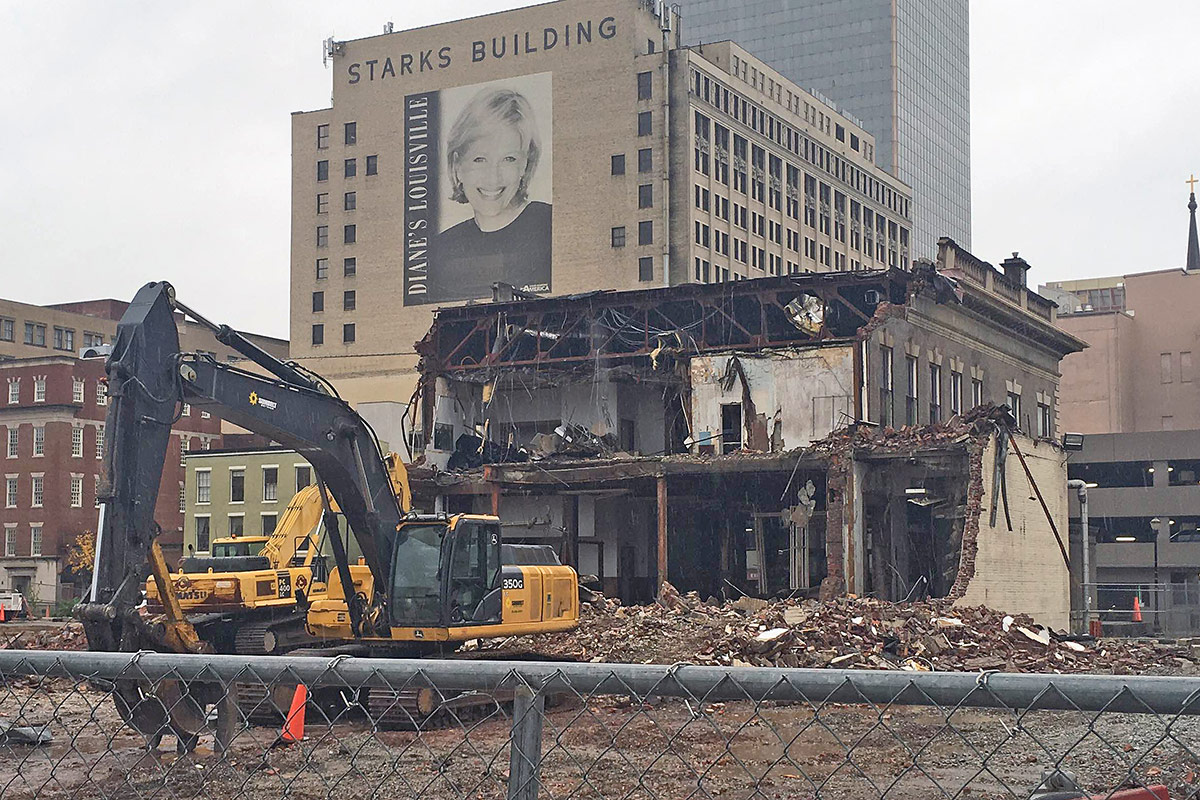
In the beginning
The mega-project began the year by exciting the public with flashy renderings and a grand vision for a rejuvenated Downtown. It’s a project Mayor Greg Fischer has called “transformational” more times than anyone can count. This is the kind of “big-time” project politicians love to attach their names to. It’s an easy win with tower cranes rising high over city streets. But silver bullets have never offered cures for urban ills. The Omni is no different.
As the year progressed, news coming from the so-called Water Company Block, bound by Third Street, Liberty Street, Second Street, and Muhammad Ali Boulevard, has taken a more somber tone.
Details emerging from the city’s secret agreement with Omni were showing the city kowtowing to the Texas mega-developer and oil-fortune heir Robert Rowling. It became increasingly clear that the public was undercut in a deal that reeked of desperation for any kind of development on the long-fallow site.
We’ve known for over half a century that silver-bullet city building won’t save the River City. But it’s easier to land one big whopper than foster along dozens of smaller projects that don’t bring the same name-brand cache. The city’s core is dotted with the same types of projects brought by each decade since the 1950s. The Omni is nothing new; it’s just the latest incarnation of 20th century development ideals.
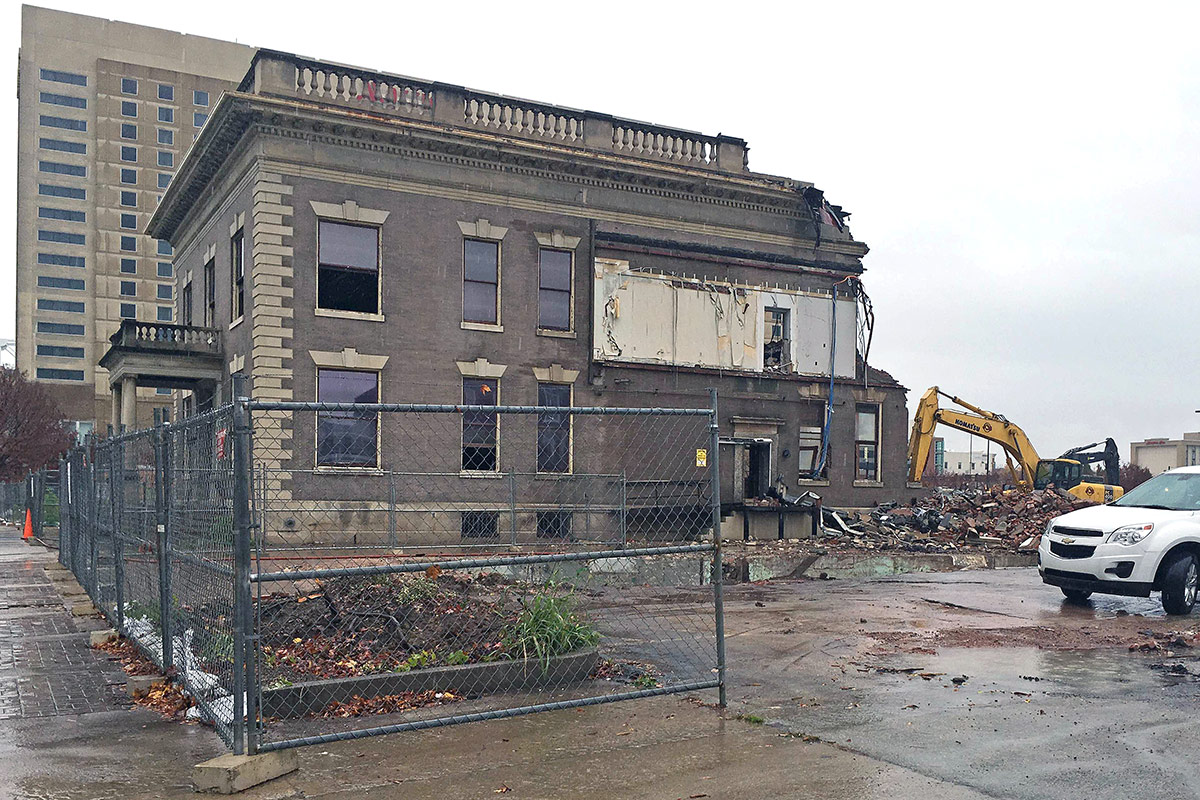
Despite all this, I’m still happy Louisville landed the Omni. It’s undeniable that the project will have a significant impact on Downtown, much of it in a positive way.
This is a project that adds a skyline-punctuating tower in a city that hasn’t seen high-rise construction for two decades on a site that’s been as flat as a pancake for decades more.
Wide Second Street will finally benefit from street wall definition, and fine-grained architecture across the street will no longer sit in isolation. In the end, anything happening on this sleepy eastern side of Downtown will send ripples of activity through the surrounding blocks.
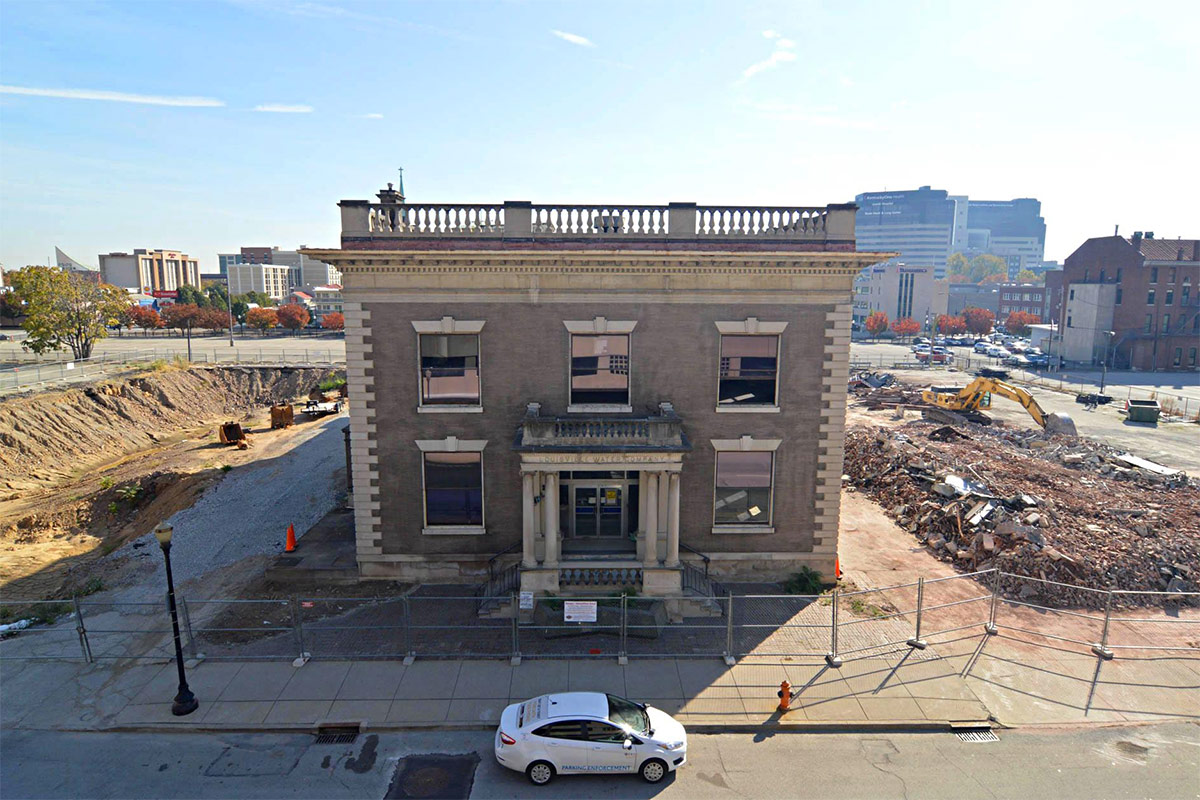
For my part, the last six months of the Omni have been tiring. They have shown a darker side of Louisville that I’m not particularly proud of—with suspect actions from Metro Louisville coming from all directions. It certainly hasn’t felt like the city has the interest of the public in mind while pursuing this deal. And that’s disconcerting when nearly half the budget comes from public sources.
I’m tired and ready to move on with construction. But I hope we can learn from what we’ve just been through and apply it forward. While we’re getting a major new development, the public process that got us here is now visibly scarred. And many in the community feel plainly left out.
As we bid farewell to the last remnants of the Water Company site and await construction early next year, here’s a last look at what it took to land an Omni.
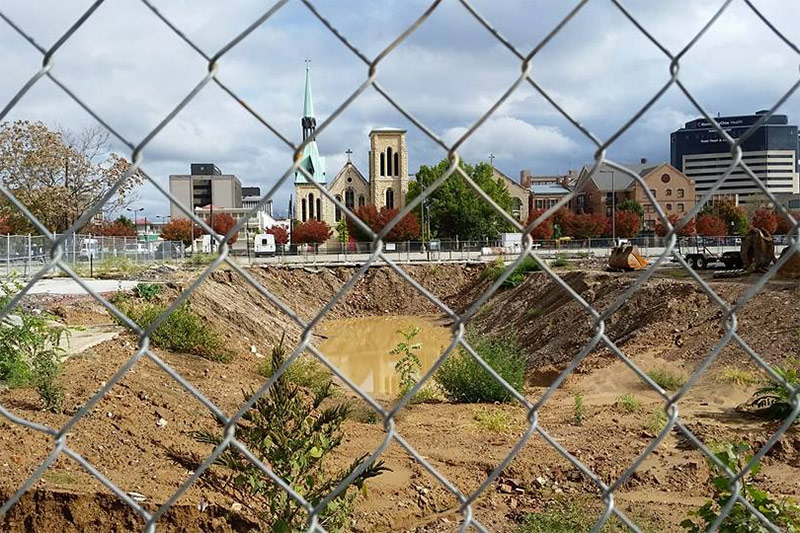
Bulldozer in a China Shop
First in a long line of demolitions on the block, an emergency order took down the Falls City Theatre Equipment Company building, the Kentucky Typewriter building, and the Morrissey Parking Garage.
Based largely on Mayor Greg Fischer’s observation of the structures and dubious city documents, the structures have remained a pit in the ground ever since. Insider Louisville reported in April that the city did not require an engineering report before leveling the structures.
This fly-by-night demolition effectively allowed the city to bypass standard public review processes, and, as would become a crucial point later, destroy the local context of the block and diminish the case for preserving its neighbor, the old Water Company Headquarters.
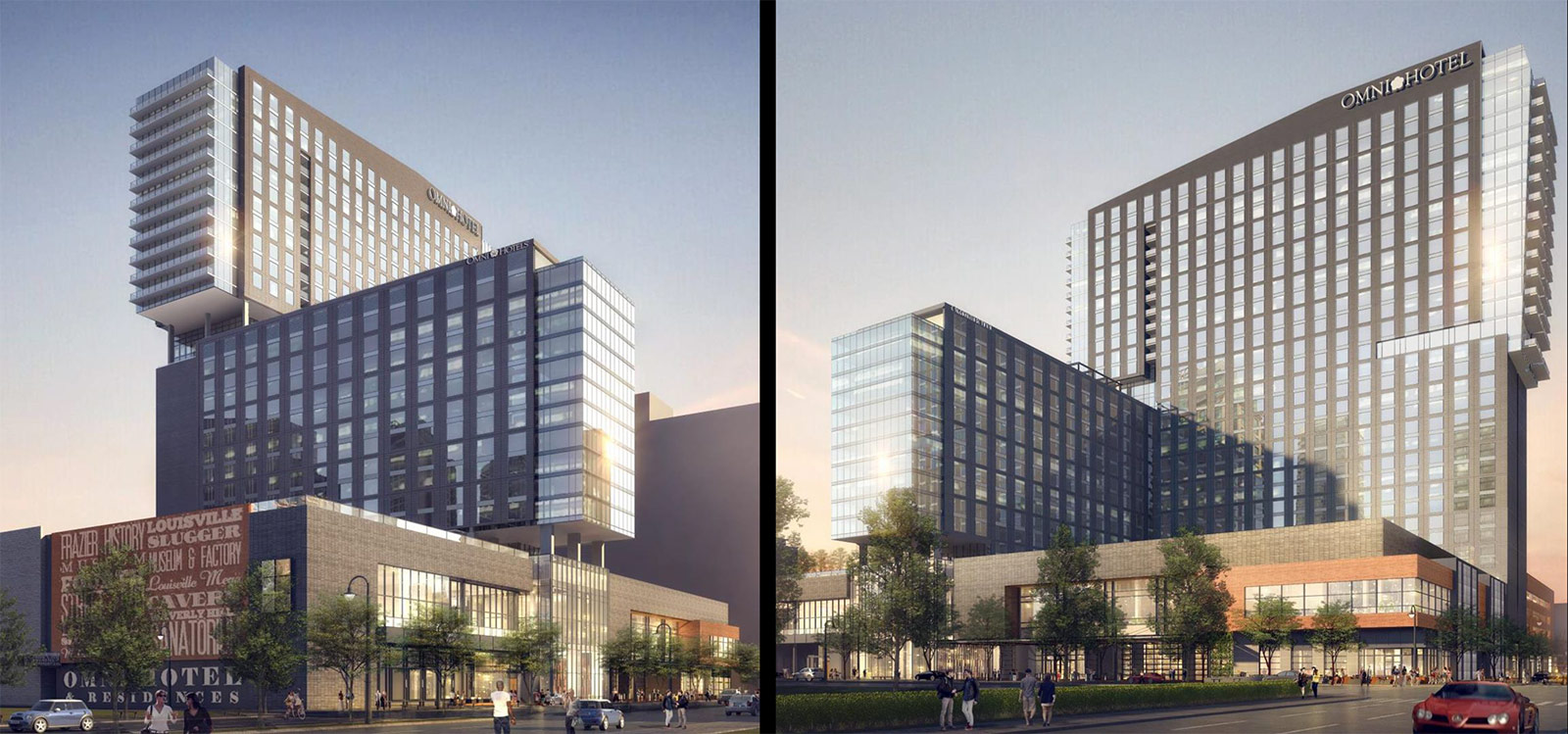
Roll over, DDRO!
Meanwhile over the summer, the city bullied its sacred cow through the public review processes of the Downtown Development Review Overlay (DDRO) committee. For a publicly funded project, there should have been a serious dialogue to make sure we were getting the best project for our money—a lot of money.
Some on the committee were generally interested in improving the project, making suggestions that would have followed guidelines put in place to create a vibrant Downtown.
Instead, Omni and the city were generally unresponsive to the committee’s requests, squandering the opportunity for discussion with last minute changes to presentation documents and legal sleight-of-hands that shut down discussion of the project before some were ready to vote.
The group ultimately gave clearance to proceed with a ho-hum design that would, among other things, create a deadened street wall for hundreds of feet along Third Street. Those amateur theatrics can be replayed over here.
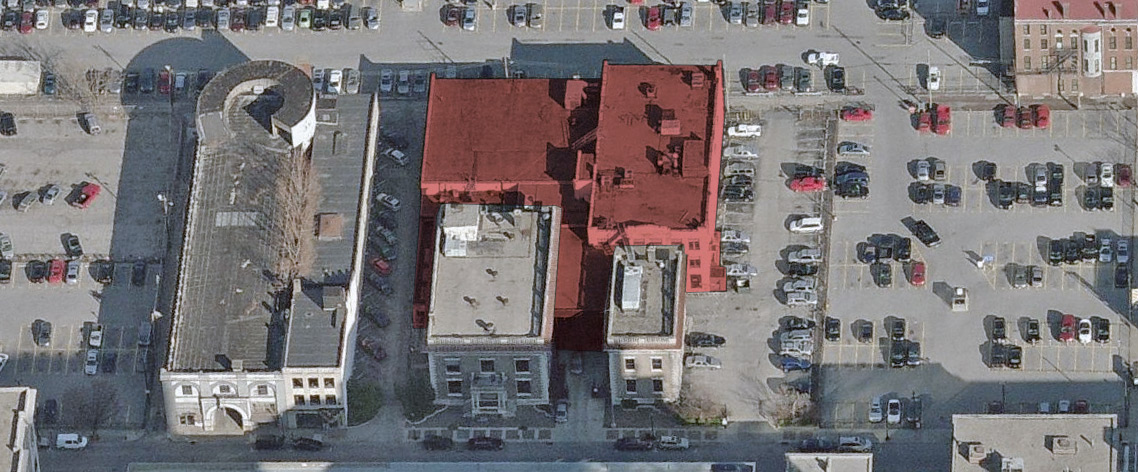
Non-contributing, now non-existent
Next in August, two brick structures dating to 1916 located behind the old Water Company Headquarters were razed. That move caught observers off guard as the city had just filed for demolition permits a dozen days before. Usually, sites like this are protected under a 30-day stay-of-demolition associated with historic properties. The city was able to proceed because the buildings were declared non-contributing by a third-party study years before.
What was left of the block was slowly dissolving.
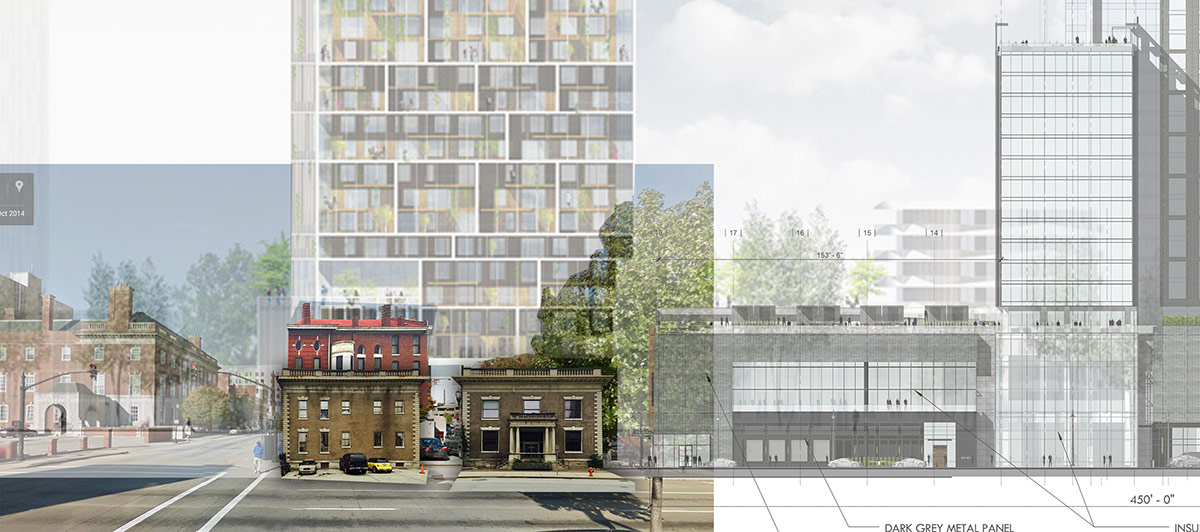
The community wants to play
Still, there was hope in the preservation community that the oldest building dating to 1910 and perhaps its smaller twin could be moved to a nearby site after the Mayor pledged a million dollars for the effort. A design charrette was convened and representatives from the National Trust for Historic Preservation attended, along with prominent Louisville architects, developers, and leaders. Several ideas were generated from that event and from other developers, but the city dismissed them in the end as infeasible.
Instead, the city promised it would haul off the disassembled pieces of the structure’s facade to Metro Archives, which is quickly becoming Louisville’s salvage yard.
Another initiative to improve the design of the Omni and add to the project’s sustainability also failed to make any meaningful impact in the project’s design.
That summer, the city began a rough-and-ready asbestos abatement program inside the historic structures. Crews ripped out mahogany paneling and damaged mosaic floors. Windows were left open to the elements and a structure that was water tight at the beginning of the year was now letting in gallons of water from holes in its roof. The city was letting the building go through neglect, and observers said at the time the damage would hamper any effort to save or move the structure.
As the demolition date for the Water Company complex approached, Neighborhood Planning & Preservation (NPP) Kentuckiana filed a petition to declare the remaining Water Company buildings local landmarks, keeping the bulldozers at bay.
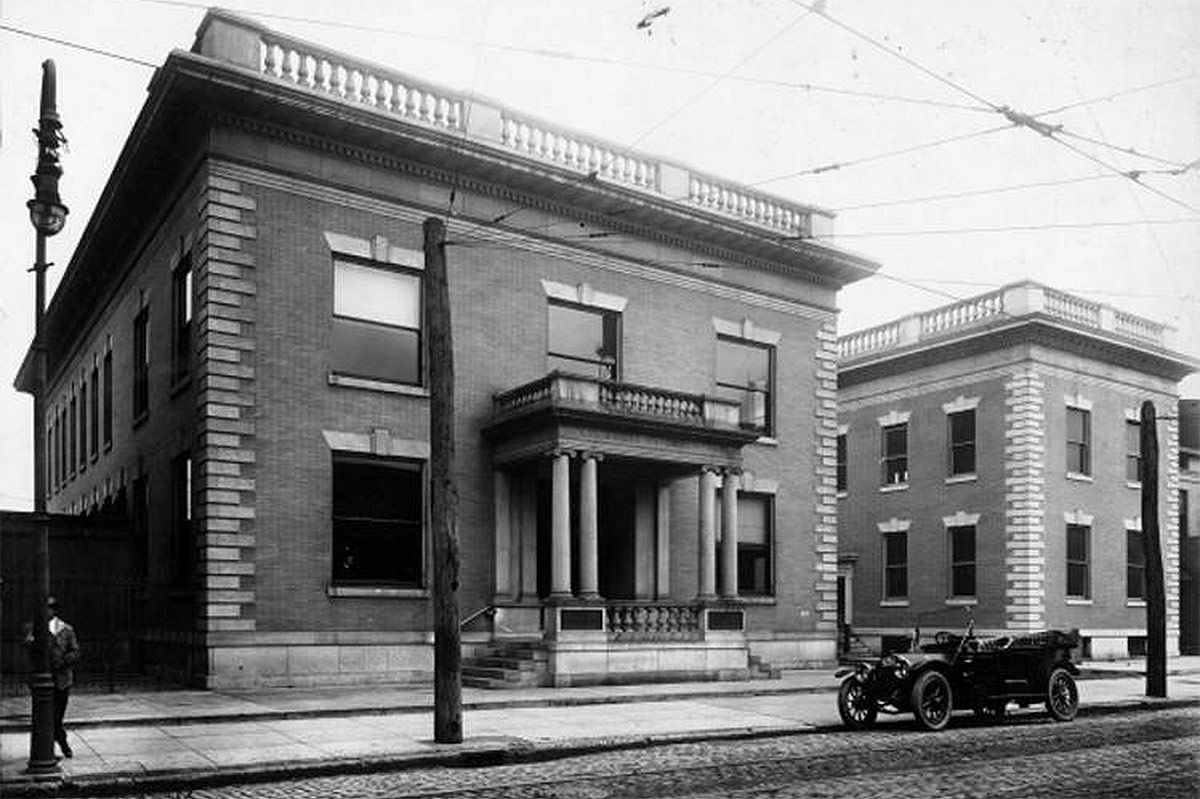
Weakened resolve
By this point, many—myself included—had given up on the Water Company site after those DDRO hearings. The city had proven ineffective at regulating a project itself was developing, and the historic building didn’t stand a chance with a newly configured Landmarks Commission operating in a politically charged climate.
An outspoken critic of the city’s plan and Landmarks and DDRO Commissioner, Scott Kremer, was relieved of his duty following those contentious DDRO meetings. Other commissioners had recused themselves because they signed the petition to landmark the structure.
Since DDRO, I’ve accepted that we’re stuck with a second-rate plan for the block, but I’m excited to move forward and get on with construction. The Landmarks petition was too little too late, and at this point, only served to delay or potentially derail the project entirely. After all, we shouldn’t let the perfect be the enemy of the good—or in this case the barely mediocre. I would have preferred to let the project continue without that final hurdle.
NPP’s petition did, however, represent the frustrations from parts of the community at the city’s disregard for the public process and existing development standards.
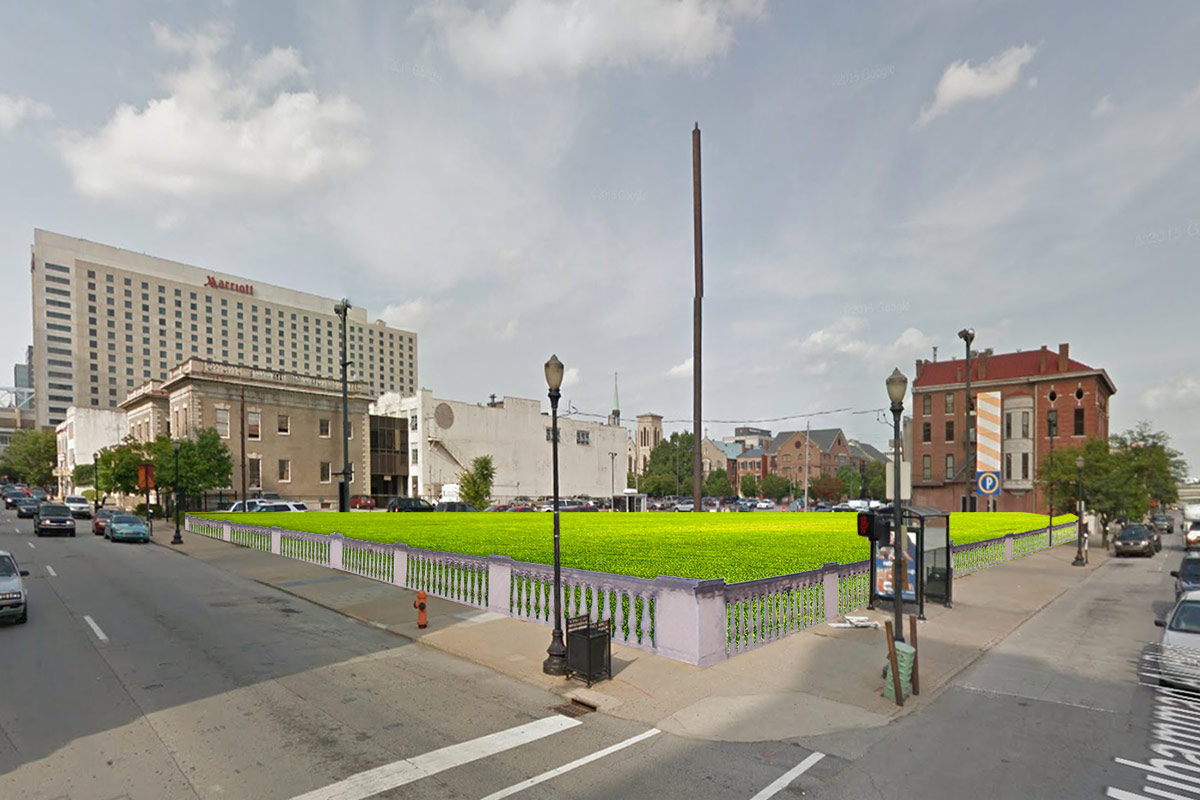
At about this time, we published an idea here on Broken Sidewalk to salvage some of the old building parts from the site to create a stone balustrade for a green space slated for the block’s undeveloped southwest corner. It was an attempt to find a compromise for salvaging more from the site and diverting local limestone from the landfill. A proposal that ultimately fell on deaf ears at the city.
Denied!
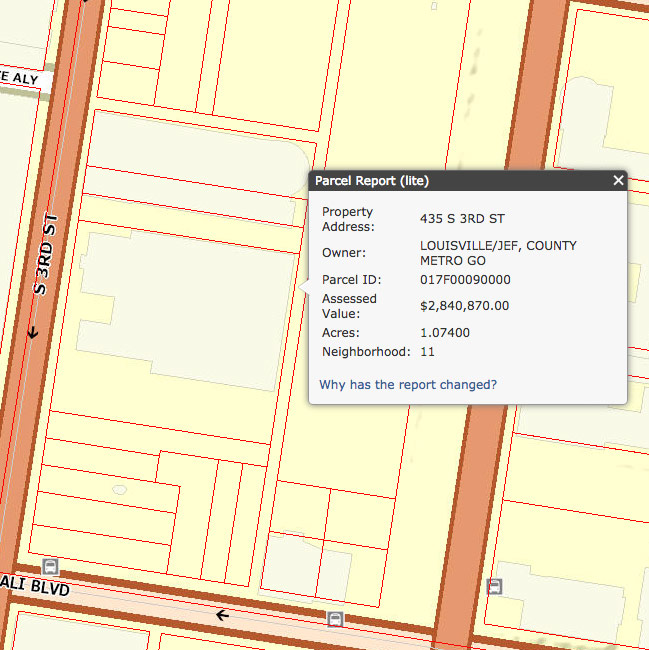
Back to that pending landmarks commission. NPP Kentuckiana believed its petition protected both the 1910 original and its 1914 twin addition when it was filed. After all, both buildings appeared on the same legal parcel (number 017F00090000) carrying the address 435 South Third Street. The city saw it differently, claiming the petition only applied to the 1910 structure.
In mid-October, the Landmarks Commission denied NPP’s petition, not so much because the site wasn’t worthy of the landmark status, but because of the economic development weight of the Omni development.
As Caitlin Bowling reported at Insider Louisville at the time, “Much of the [Landmarks Commission] meeting focused on how landmarking the Water Company building would impede the $289 million Omni Hotel project as opposed to the merits of whether the building deserved landmark status.”
As Louisville’s landmarking and preservation laws go, this attention to economic impact is a relatively new consideration for the panel. It ultimately weakens the ordinance’s ability to protect the city’s built heritage.
Had the site received landmark status, it would have thrown a monkey wrench into the Omni development since the city is contractually obligated to deliver a blank site to Omni by the first of the year. And it ultimately would not have prevented the destruction of the Water Company Building.
Archiving rubble
The very next day, the city sent wrecking crews to level the smaller 1914 structure, sending most of its stone pieces to the scrap yard. Photo tipsters noted that while dozens of balusters and other stone elements could be seen in the rubble, a stack of stone pieces was visible stored in an adjacent parking lot.
The city has promised a salvage operation in lieu of preservation for the building, storing building elements for later reuse. As we reported earlier, Louisville has put dozens of building components in storage over the years, few of which have resurfaced. City officials promised this time would be different.
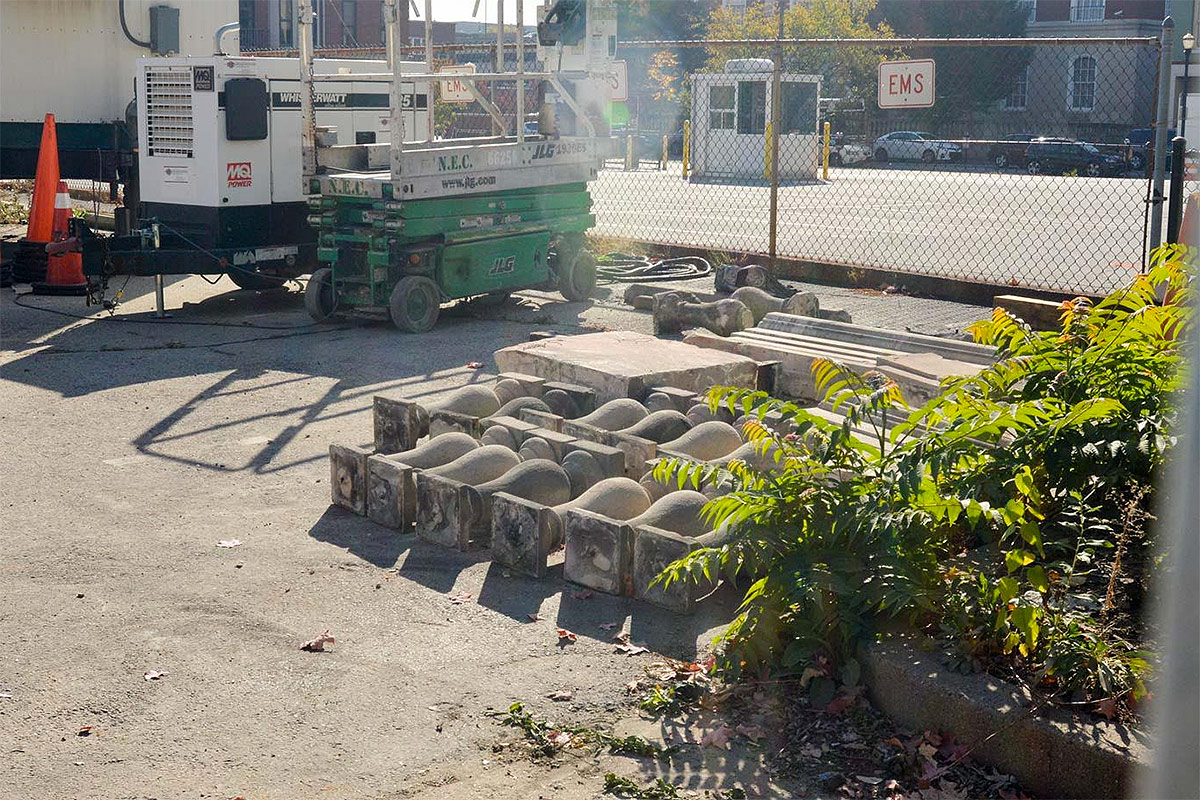
“The most architecturally significant portions of the buildings—the facade, portico, and approximately 25–30 feet of the side walls—will be carefully disassembled and placed in storage at 7th and Industry,” Will Ford, communications specialist at Develop Louisville, wrote to Broken Sidewalk in an email on Friday.
“We will then, sometime in the next 12 to 18 months, solicit proposals for the reassembly and reuse of the building,” he added. “This will allow sufficient time for interested parties to fully develop a proposal and business plan that will make the best use of the Water Company building and will hopefully make it productive and relevant for generations to come.”

The Appeal
NPP Kentuckiana said in media reports immediately following the Commission’s ruling that it planned to appeal the decision to deny landmark status. Insider Louisville’s report cited a letter NPP Director Martina Kunnecke sent to Cynthia Johnson, the city’s historic preservation officer, in which she “expected the building not to be disturbed until the appeals process is complete,” despite the demolition of the 1914 structure.
“We have 90 days to file so we wanted to remind the city this morning that by law even though we were rejected we have recourse,” Kunnecke told Insider.
At the end of October, the Courier-Journal‘s Sheldon Shafer reported that the city had no plans to honor the 90-day appeal window. Johnson responded to Kunnecke’s letter with a link to the video of the Landmarks Commission meeting and a spokesperson indicated the city would proceed with demolition after 30 days.
The clock was ticking on a deadline to hand over a cleared site to Omni. The 90-day window would have pushed the public process well beyond that point, giving Omni a chance to back out of the deal.
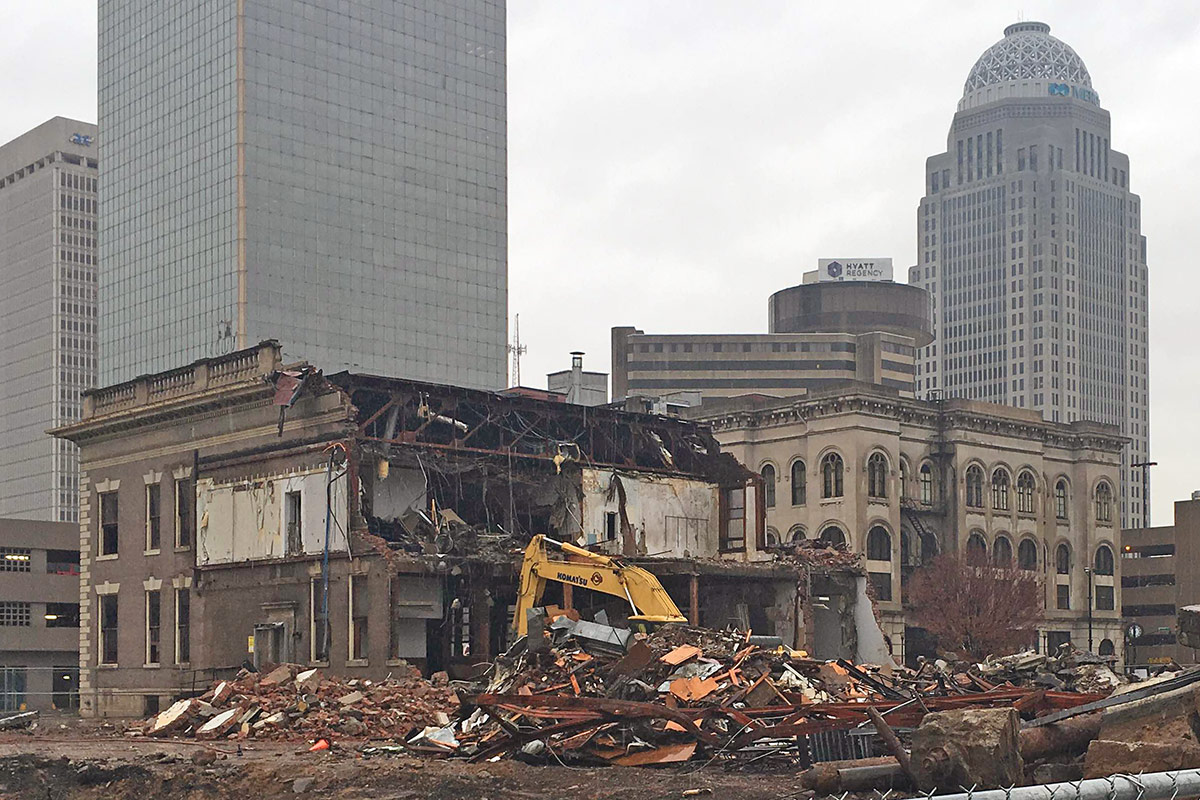
The Final Countdown
Metro Louisville remained true to its 30-day word, last week resuming demolition work on the Water Company Building.
“The county attorney has advised that the appeal period is 30 days when the landmarks commission does NOT grant landmark status, as is the case with the old Water Company building,” Ford wrote to Broken Sidewalk Friday in an email. “That 30 days ended at midnight Monday.”
The official Landmarks Ordinance, above, states that “an appeal from the Commission shall be taken by any person or entity claiming to be injured or aggrieved by the final action of the Commission to the Jefferson Circuit Court within 90 days of the Commission’s final action, which shall be defined as the date on which the Commission votes to approve or disapprove the matter giving rise to the appeal.”
We asked Ford to clarify the 60-day discrepancy between the ordinance and the county attorney’s interpretation, but he did not reply by press time.
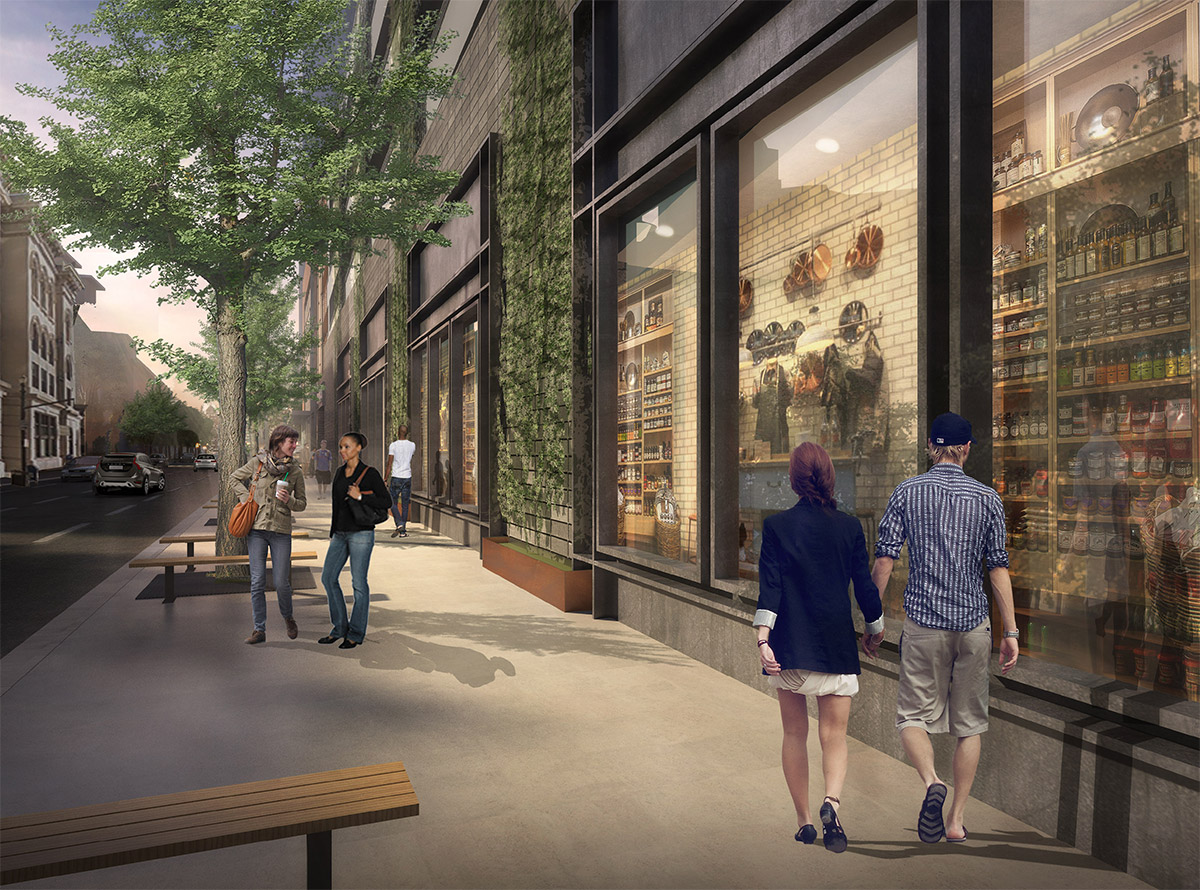
Next things next
So here we are at the end of the process, at the end of the year—about a month before the city must hand over the block to Omni—and it appears as though that deadline will be met. By this time next year, there will be serious construction taking place on the Water Company Block as the Omni speeds toward its 2018 opening.
I’d like to think that we learned something along the way, but in reality, we probably didn’t. That’s because we didn’t learn anything the last time this exact same thing happened a decade ago with the building of the Marriott Hotel directly north of this site.
There, an entire National Register historic district was demolished for the convention center hotel and its ballrooms. A sub-standard design with significant public subsidy created its own dead zones on three sides of the block.
History was repeated at the Omni, only in grander scale. We must make sure it doesn’t happen again.
In the process of getting a very expensive mega-development, we’ve gutted the public review process meant to safeguard high standards of design Downtown. We’ve undercut the historic preservation process in this city, and we’ve disenfranchised a group of citizens who cares deeply about the future of Louisville. All because the city chose to handle the development behind closed doors with no community input.
As a result, Louisville won’t be getting the best Omni it could have, but it will get the Omni it deserves. And at such a high price financially and culturally. But it’s time to move on and let construction begin.

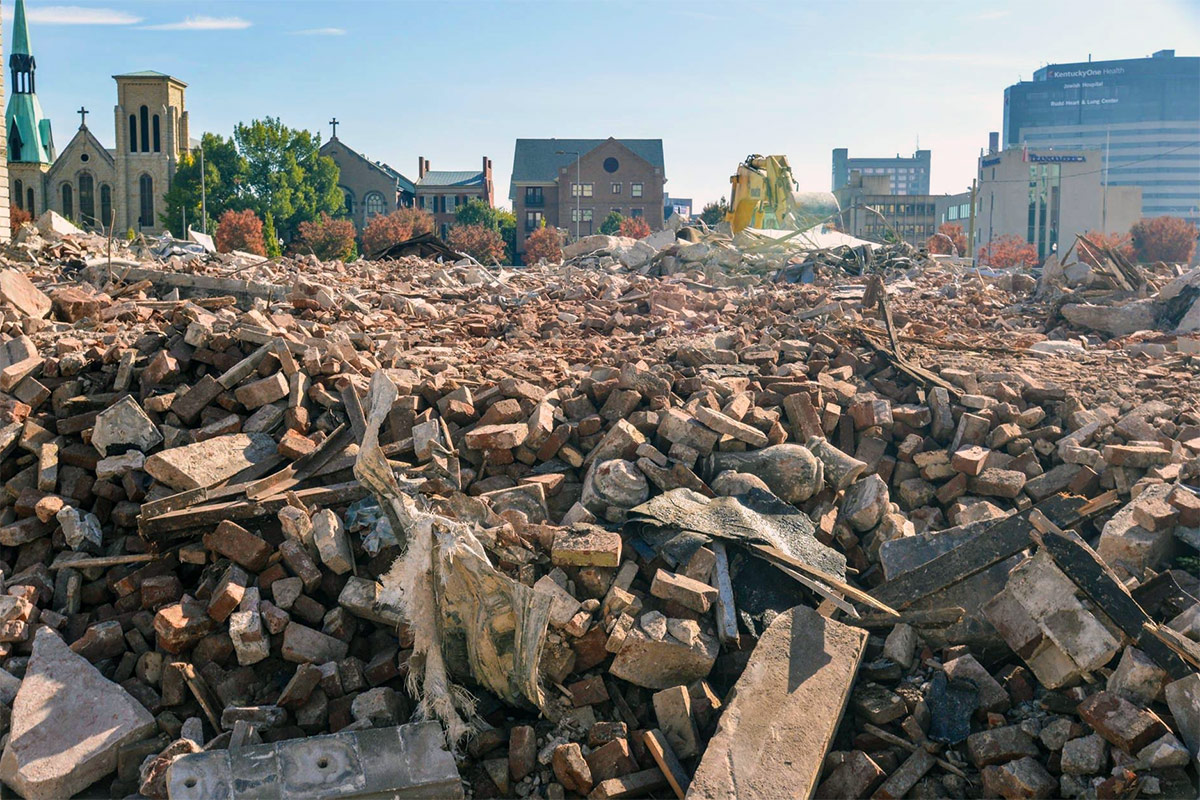

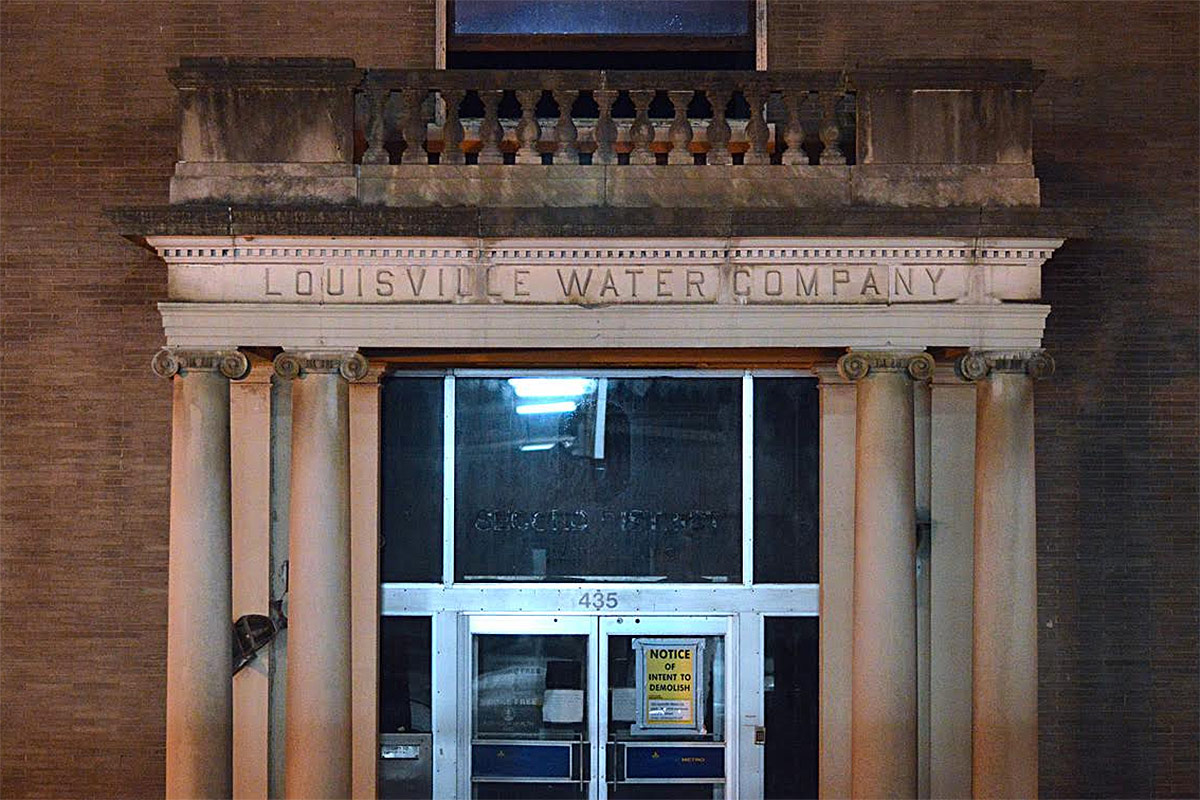
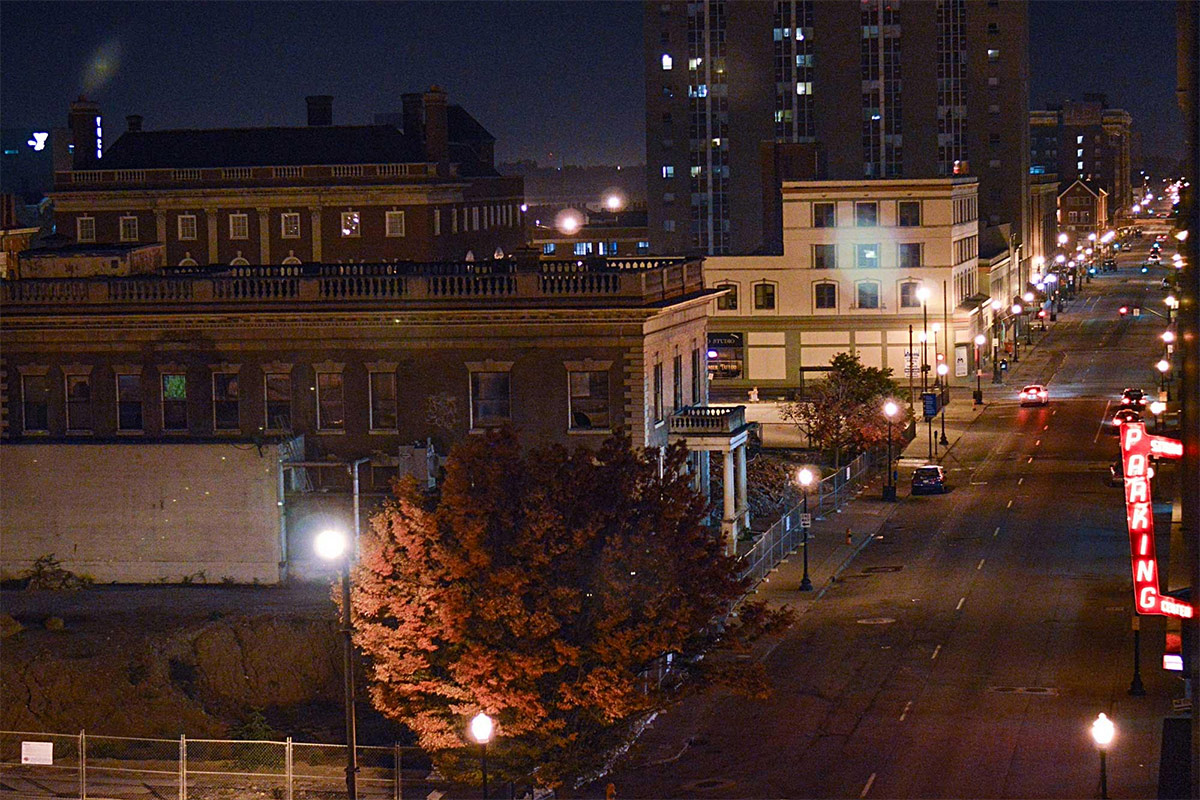

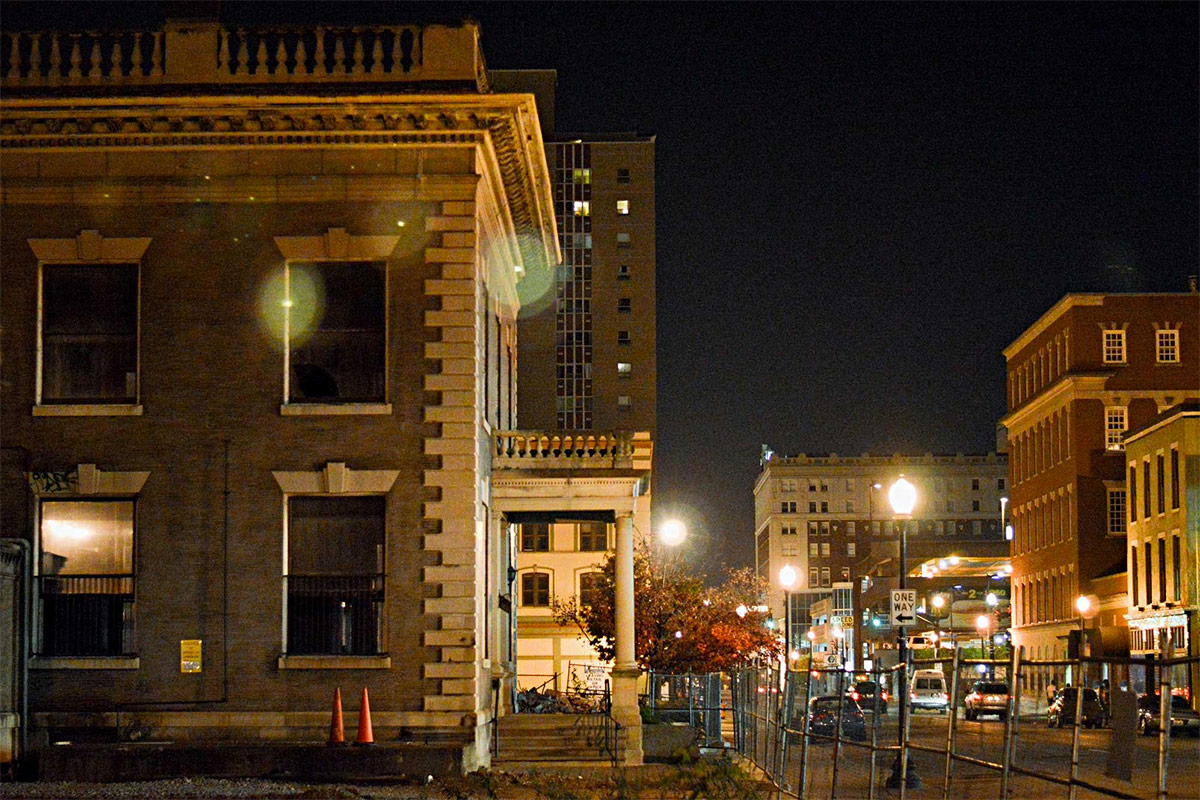
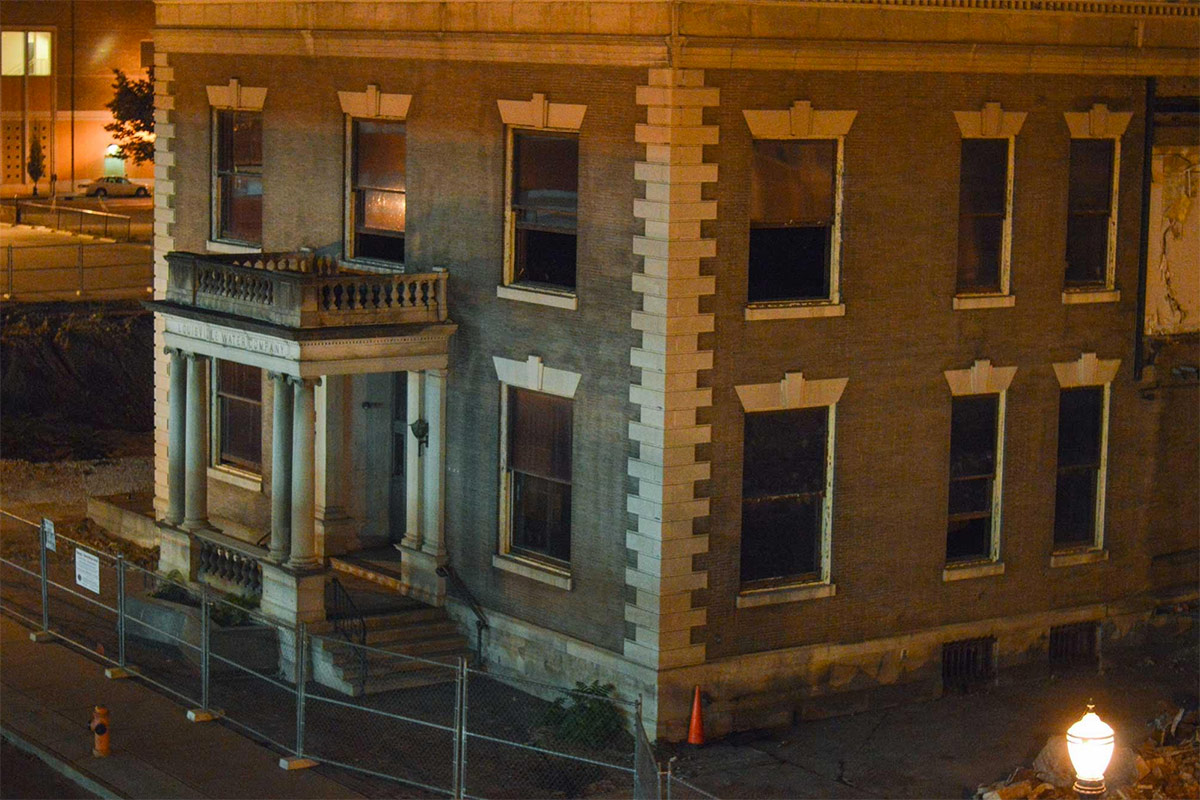
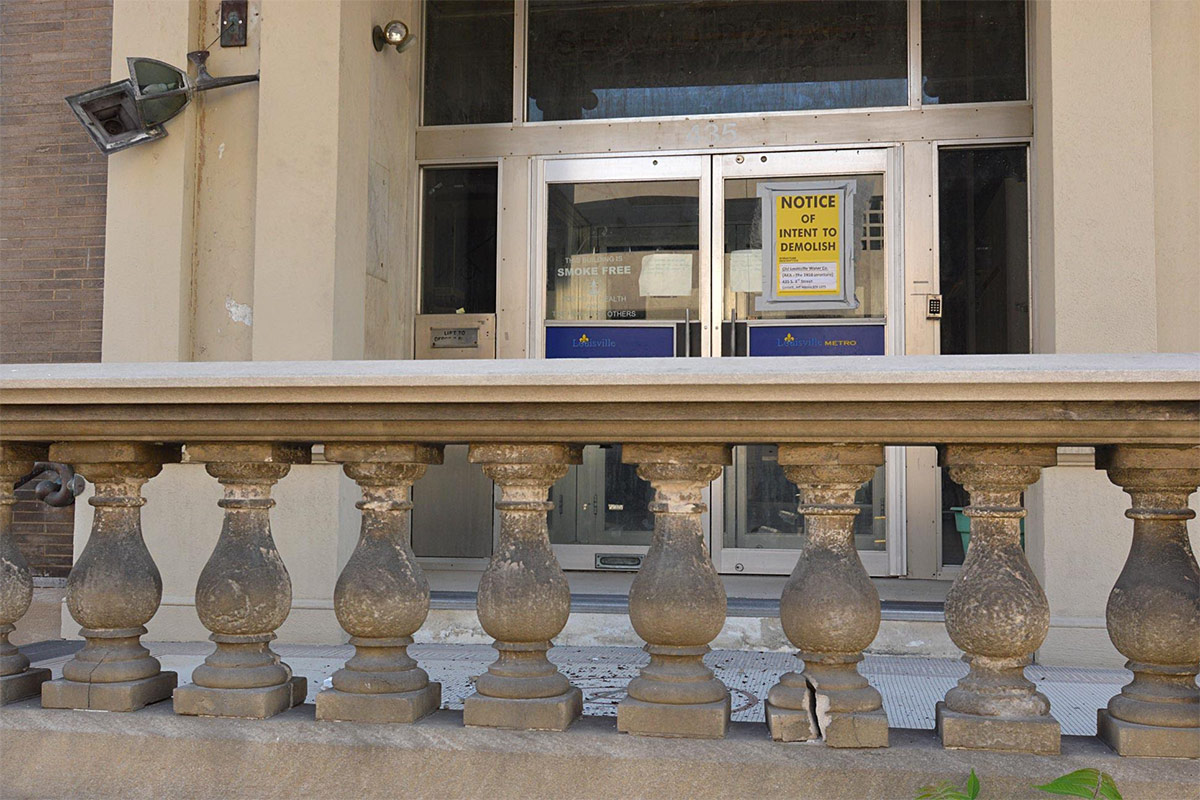
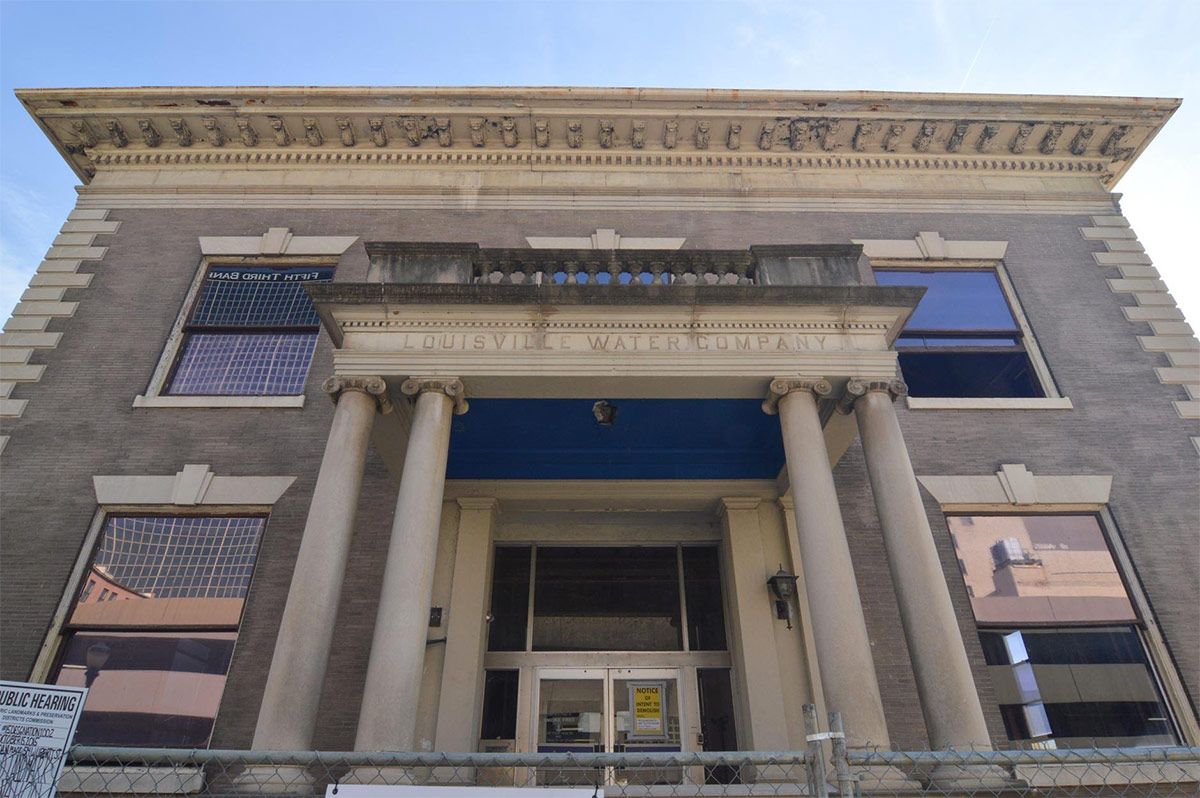
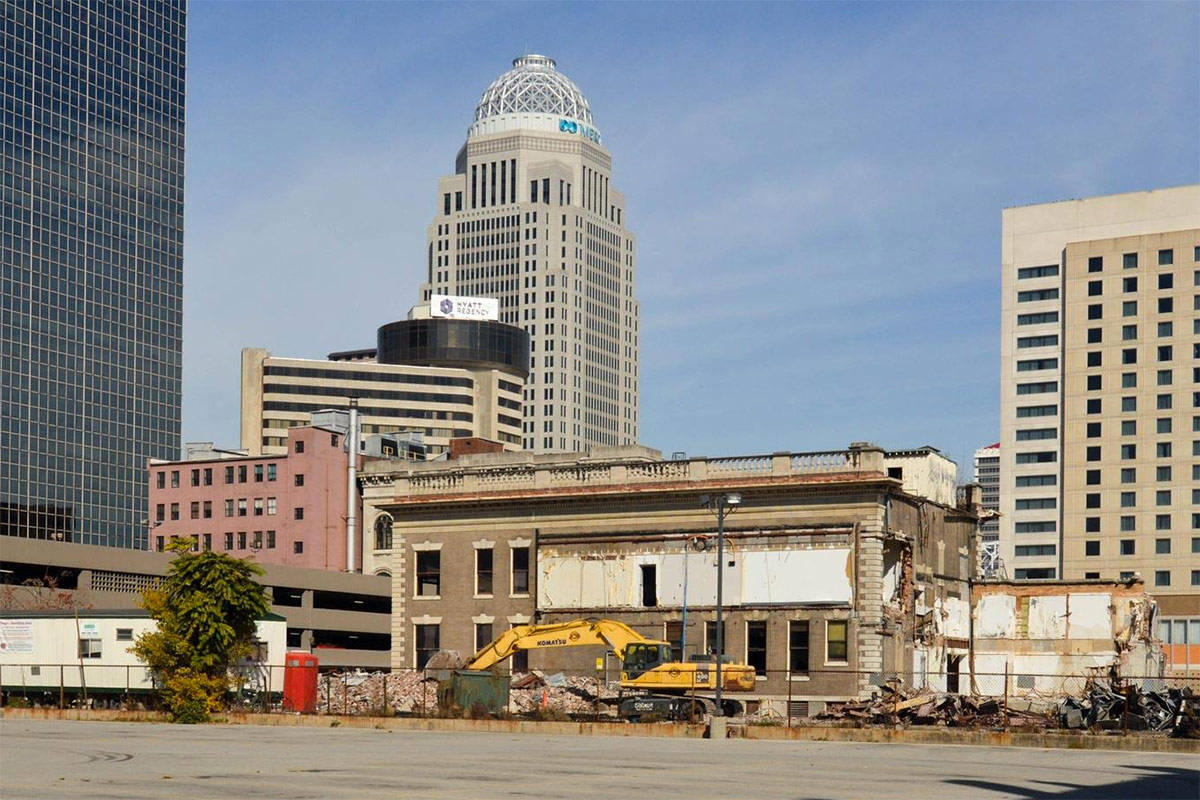
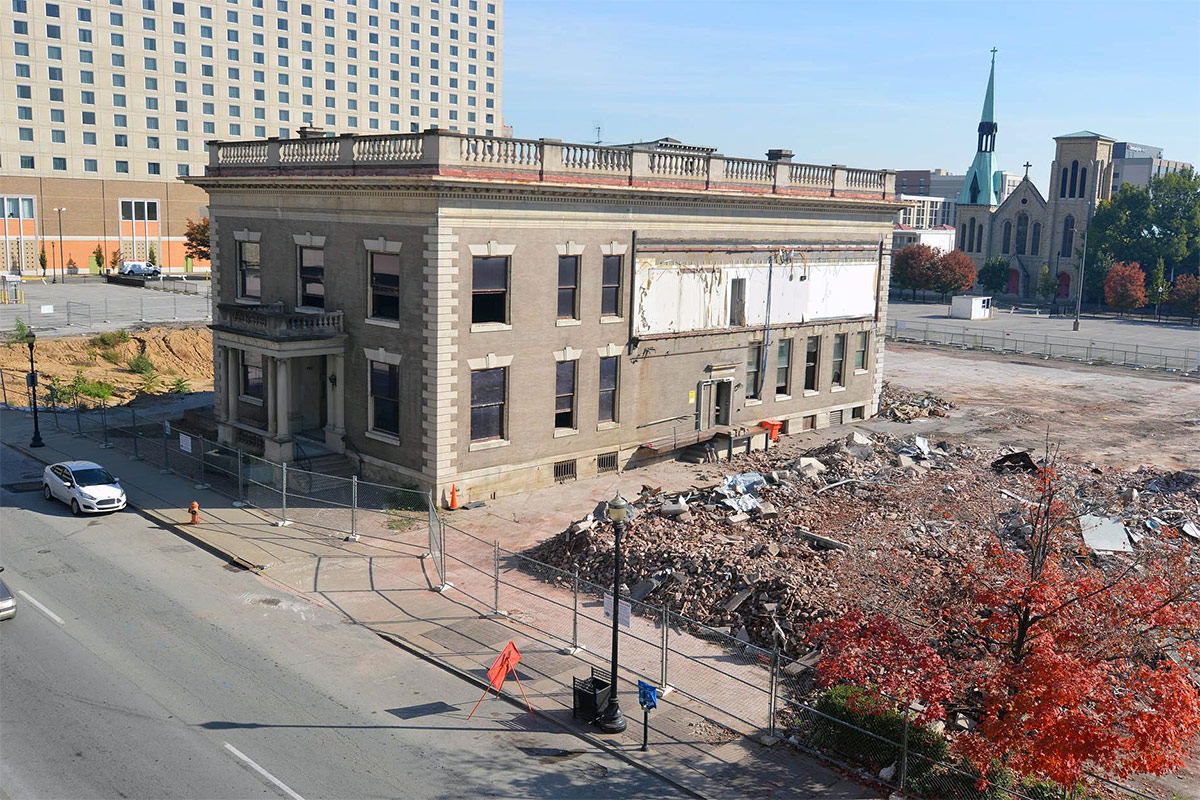
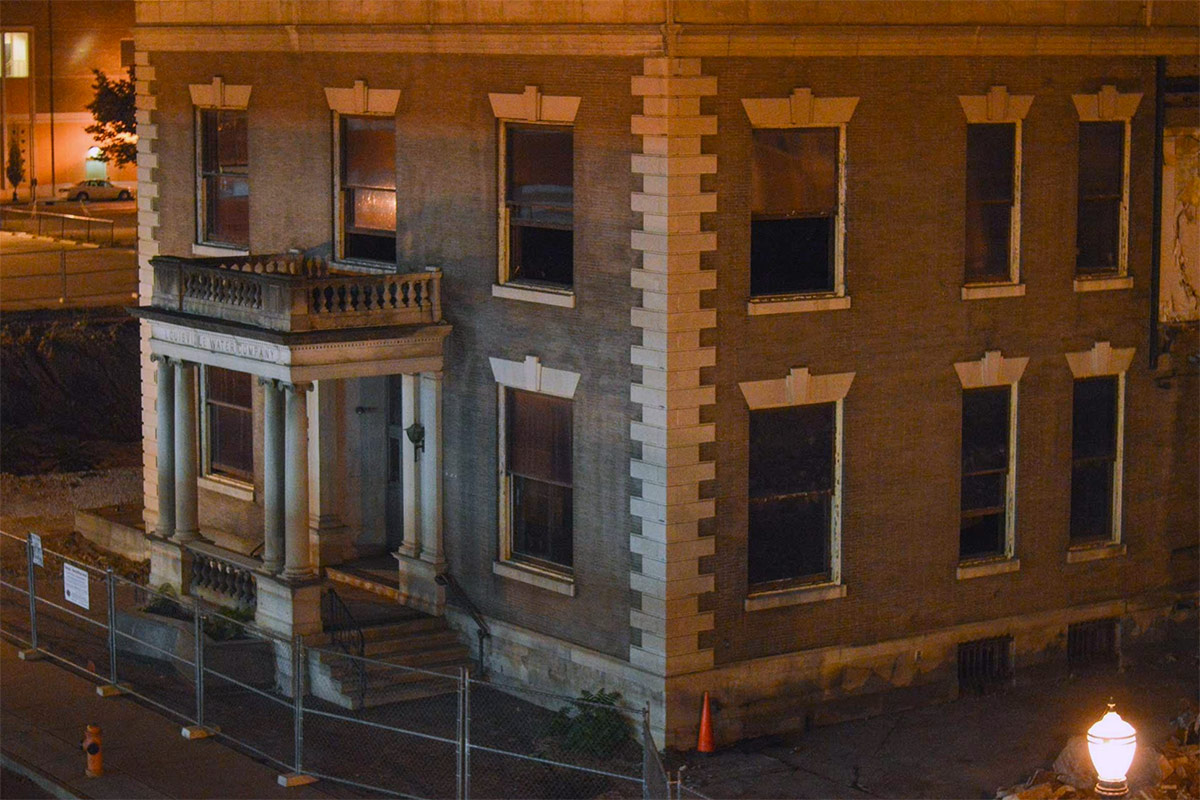
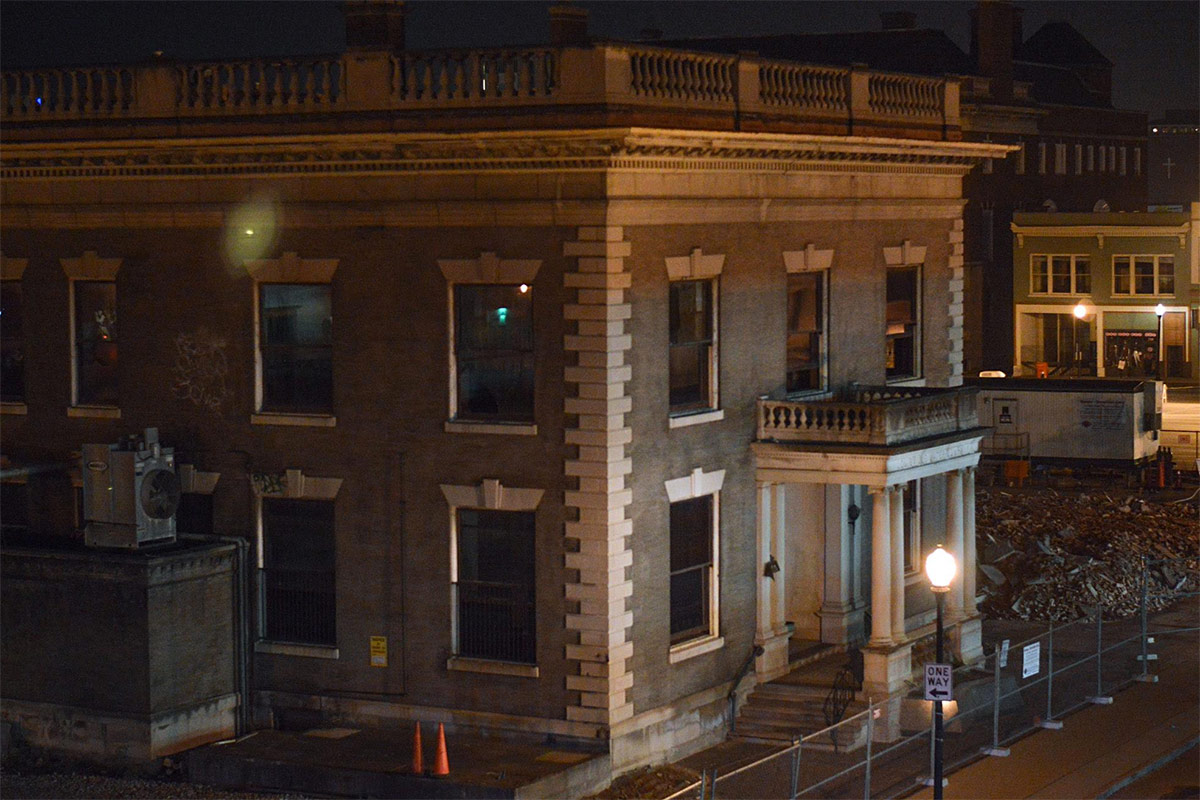


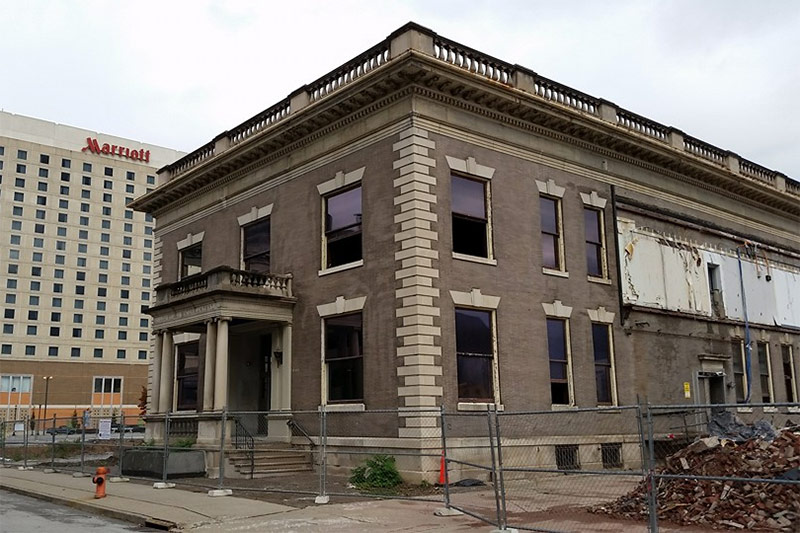
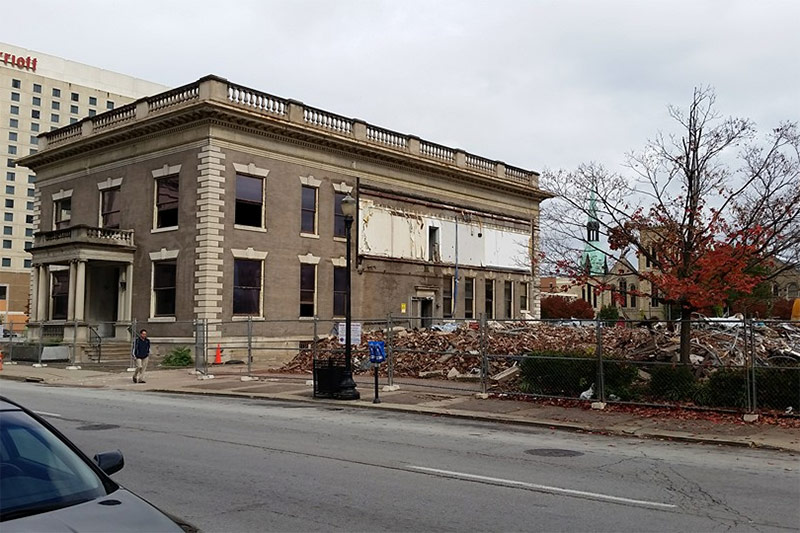
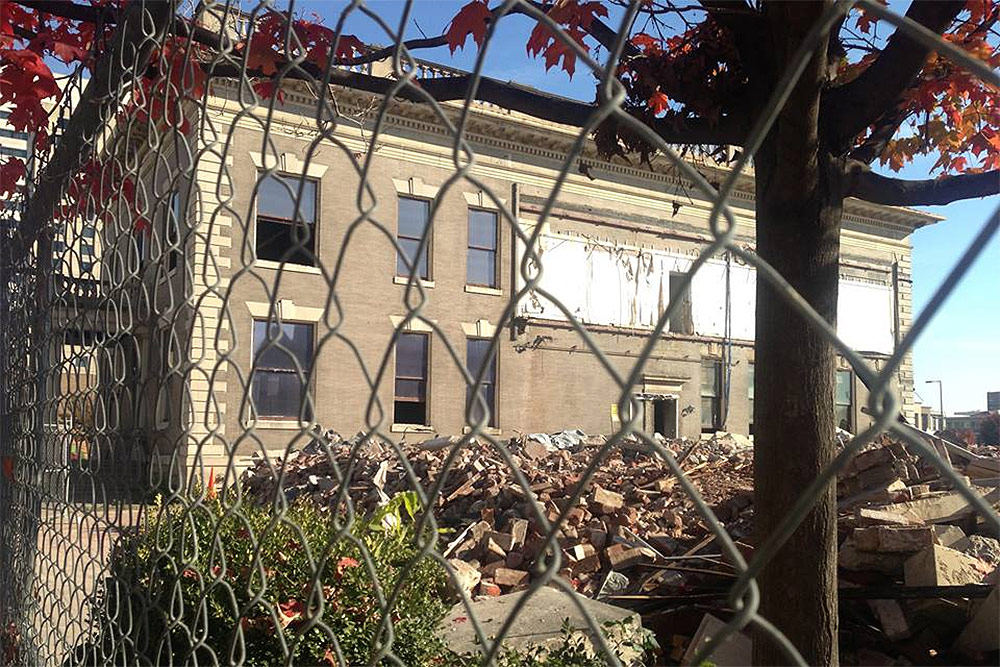

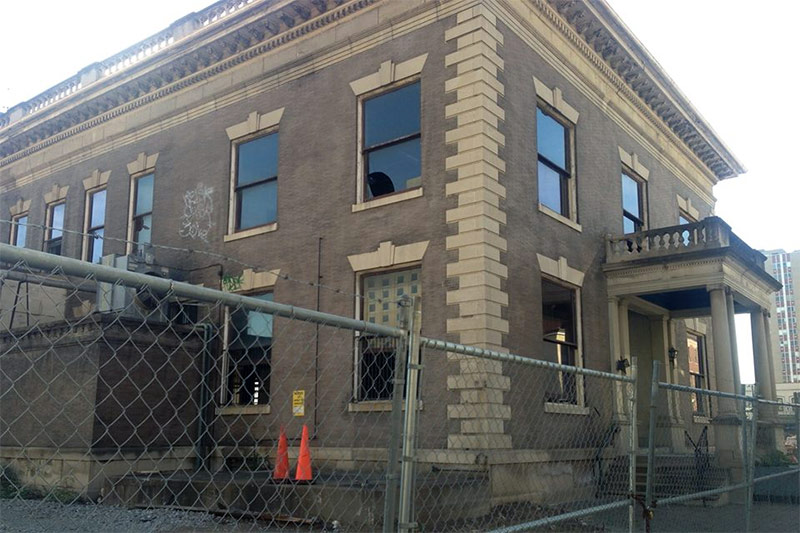


It feels like 1979 all over again. Dynamic models of the Galleria that wasn’t ever to really be in the Stewarts lobby, whisked away after a week and never seen again. Standing on the corner of Will Sales and Fourth getting people to sign petitions to stop wholesale demolition of a marvelously quirky block……, demolition begins and Will hurls a few large pieces of limestone into the Hyatt glass walls, as if to say NO…….. The wooden brick alley behind her is dug up, with a wooden brick in the backseat mocking me…….and finally the ribbon cutting, where bricks from the Will Sales are mounted on plaques like elephant tusks ripped from their bodies ……and today Insider Louisville confirms that Metro and GLI will continue to collude to destroy the rest of preservation and design review regulations so we can be pillaged at will………yeah. It’s 1979 all over again, and smoke and mirrors rules the day.
Why can’t the city learn from it’s past mistakes? The Omni is a big deal but that corner of third and liberty is going to be permanently crippled by sharing the corner with a parking garage and the backside of the Marriot that offers nothing of interest. Now the rest of third street will be dead and whatever goes along liberty will have to contend with gas fumes and trucks pulling into the Marriot. I hate to say it but it seems like this development will suffer the same fate as the Marriot, whose facade is okay in terms of interest but because of its isolated location that offers little incentive to walk to it from fourth street, and be another big development only used by the people who stay at the hotel and the few people that will live there. That big dead block on liberty between third and fourth will be a huge obstacle in drawing people to the Omni, just as the dead block on jefferson is.
I pretty much concur with Brandon’s commentaries in the above article. Sadly, that block lay dormant and undeveloped for years. The Omni and Convention Center were intrinsically linked–one project relying on the other for a total tune of about a half billion dollars. Maybe its time to use énergies to find placement for the historic stored parts.
I think that it is great that the omni hotel is being built. What the heck can we do with the old water company building anyways. It is time leave the past behind us a begin progress. This is not 1979! Louisville is much bigger and progressive than it was in 1979. More people are comming downtown and saying the hell with the suburbs. I know this is great for the city and great for the evolution of Louisville. Shame on you nay Sayers!
I never like seeing historical properties being destroyed but I tend to agree with the above Poster. downtown needs more visitors and activity that the old Water building was never going to attract
@Frank & John G: The discussion is not about the Omni versus keeping the Water Co bldg. That’s a false dialogue that was created through the past year due to the city’s & Omni’s resistance to be transparent. There’s nothing mutually exclusive about it. What’s wrong here is that the city chose not to be open about the site planning process and chose to put parking above ground, which required a clear slate. They broke the rules that govern development downtown. It’s unfortunately just like 1979. That’s what we should be moving away from.
Found this great shot while researching something else–felt this was an appropriate place to share:
http://digital.library.louisville.edu/cdm/ref/collection/cs/id/698